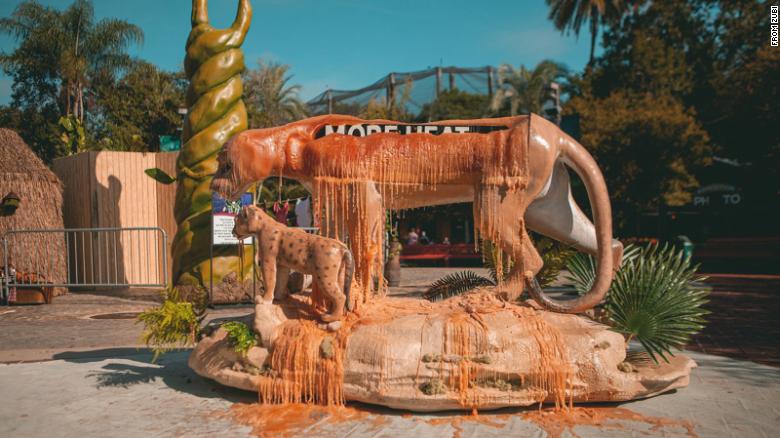Orange wax streams down the back of a sculpture of a Florida panther, sending a message.
She will soon be gone, leaving her cub behind.
The melting wax panther is an artistic metaphor for the toll human-caused climate change is taking on Florida’s wildlife and people. And scientists say it could get even worse.
A record hurricane season, coastal flooding, rising temperatures and long stretches of extreme heat are just some of the ways climate change is playing out in the Sunshine State.
The piece of “artivism” is part of the Florida Climate Crisis Campaign by The CLEO Institute, a nonprofit focusing on climate science education in Florida, and the VoLo Foundation.
“We are having a very hyperactive hurricane season and we have run out of names to name them. We are experiencing increased temperatures and increased sea level as well,” Yoca Arditi-Rocha, executive director of The CLEO Institute, told CNN. “For us the climate crisis is very relevant and it’s impacting Floridians in so many ways.”
The panther sculpture debuted at ZooTampa on Friday to depict how the habitat of endangered species is affected. It is one of three installations being placed in different cities.
Artist and director Bob Partington created the three wax sculptures, which were commissioned by Miami-based advertising agency Zubi.
Each sculpture is meant to melt over a few days, slowly revealing a message about climate change. Wax was chosen to emphasize the increasing temperatures in Florida, Arditi-Rocha said.
The first artwork was a wax sculpture of a lifeguard hut like the ones you see on Florida’s beaches. Installed in Miami, it represents Florida’s tourism industry and its quality of life.
The artwork melted to reveal this message: “More Heat, Less Beaches.”
Miami saw a record summer with weeks of intense heat. Seven of the 10 hottest weeks on record have occurred in 2020 and that was before August, when temperatures traditionally peak in the city.
The final wax sculpture, to be unveiled in front of Orlando’s city hall this week, will show a man and his granddaughter sitting on a bench. The artwork is meant to make people question what will be left of Florida’s natural wonders for future generations, The CLEO Institute said in a press release.
“The idea of these icons is to highlight things that all Floridians really want to protect and treasure,” Arditi-Rocha said.
While climate change is a global issue, the CLEO Institute is hoping that Floridians take a look at what they love about their state and work to save it.
“Our passion to save our way of living here in Florida is widely shared among so many of us,” Arditi-Rocha said. “We know this is a topic that has been tremendously politicized, but everyone wants to protect our beautiful beaches, our biodiversity and our way of living.”
>>>details



